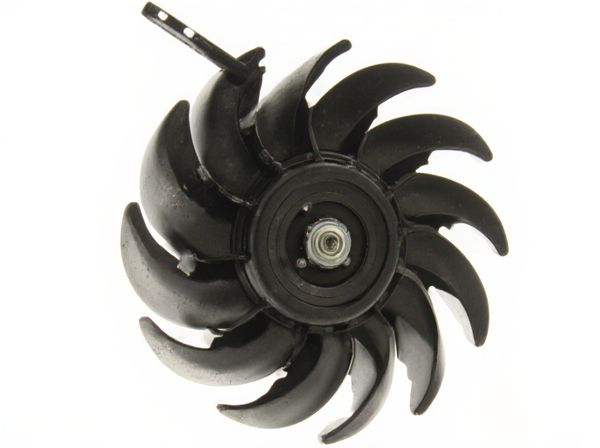
Photo illustration: Hairpin vs Conventional Winding
Hairpin winding offers higher current capacity and improved thermal management compared to conventional winding, making it ideal for high-performance electric motors. Conventional winding, often used in traditional motor designs, provides flexibility in coil shapes and simpler manufacturing processes. Your choice depends on the desired efficiency, manufacturing complexity, and application requirements.
Table of Comparison
| Feature | Hairpin Winding | Conventional Winding |
|---|---|---|
| Copper Usage | Higher, enabling improved conductivity | Standard, less efficient copper distribution |
| Current Capacity | Increased, supports higher amperage | Moderate, limited by wire gauge |
| Heat Dissipation | Enhanced due to flat conductor shape | Less efficient, round wire limits cooling |
| Manufacturing Complexity | Higher, requires precise bending and welding | Lower, simpler winding process |
| Durability | Improved mechanical strength | Standard mechanical reliability |
| Cost | Higher due to complex production | Lower, cost-effective manufacturing |
| Application | High-performance and heavy-duty alternators | General automotive alternators |
Introduction to Hairpin and Conventional Winding
Hairpin winding uses rectangular copper bars precisely bent into U-shaped loops, allowing increased slot fill and improved thermal management compared to conventional round wire windings. Conventional winding employs round copper wires wound in multiple turns to form coils, offering flexibility but limited slot fill and higher electrical resistance. Hairpin winding enables higher power density and efficiency in electric motors, making it suitable for modern automotive and industrial applications.
Fundamental Differences Between Hairpin and Conventional Winding
Hairpin winding uses rectangular copper bars interlocked in stator slots, offering higher slot fill and improved thermal dissipation compared to conventional winding, which employs round copper wires wound in coils. The fundamental difference lies in the mechanically robust structure of hairpin winding that enables higher current density and automated manufacturing processes, while conventional winding allows flexibility in coil shapes but presents limitations in thermal management. Hairpin winding is preferred in high-performance electric motors due to enhanced efficiency and power density, whereas conventional winding remains common for varied motor applications with diverse design requirements.
Construction and Design Features
Hairpin winding utilizes rectangular copper conductors bent into U-shaped loops, allowing higher slot fill factors and improved thermal management compared to conventional winding, which employs round wires wound in multiple layers. The rigid structure of hairpin winding facilitates automated assembly and reduces winding resistance, enhancing motor efficiency and power density. Conventional winding offers flexibility in coil configuration but often results in increased end-turn length and copper losses due to overlapping layers.
Manufacturing Processes Involved
Hairpin winding manufacturing involves precise automation using robotic systems to insert pre-formed flat copper conductors into stator slots, followed by welding at the ends to form solid electrical connections. Conventional winding requires a coil insertion process where insulated round copper wires are manually or semi-automatically wound into stator slots, demanding additional insulation and impregnation steps to secure and electrically isolate coils. Both processes include precise slot insulation, meticulous coil placement, and thorough quality checks, but hairpin winding benefits from higher automation, leading to improved repeatability and reduced labor costs.
Electrical Performance Comparison
Hairpin winding offers superior electrical performance compared to conventional winding due to its higher slot fill factor and reduced resistance, which decreases energy losses and improves efficiency. The solid rectangular conductors in hairpin winding enhance thermal dissipation and allow for higher current densities, resulting in increased power output and better thermal management. Conventional winding, typically using round wires, often has higher resistance and lower mechanical stability, leading to greater copper losses and reduced overall motor efficiency.
Thermal Management and Efficiency
Hairpin winding offers superior thermal management compared to conventional winding due to its larger cross-sectional conductor area, which reduces electrical resistance and heat generation. This design enhances efficiency by minimizing energy losses and improving heat dissipation, allowing for higher current densities and longer motor lifespan. Conventional winding, while simpler, typically experiences higher thermal buildup and lower efficiency because of smaller conductor sizes and less effective cooling pathways.
Cost Implications and Scalability
Hairpin winding reduces copper losses and improves slot fill factor compared to conventional winding, leading to enhanced efficiency and lower operational costs in electric motors. While initial manufacturing costs for hairpin winding are higher due to automation and precise equipment requirements, scalability benefits arise from faster production cycles and repeatability, making it cost-effective for large-scale manufacturing. Conventional winding offers lower upfront tooling expenses but faces limitations in scalability and higher labor costs, which can increase total expenditure in mass production scenarios.
Applications in Modern Electric Motors
Hairpin winding technology enhances electric motor performance by enabling higher slot fill factors and improved thermal management compared to conventional winding. Modern electric vehicles and industrial motors benefit from hairpin winding's ability to deliver increased torque density and efficiency under high-speed conditions. Conventional winding remains prevalent in applications prioritizing cost efficiency and simpler repair processes, such as small appliances and low-power electric tools.
Advantages and Disadvantages of Each Winding Type
Hairpin winding offers advantages such as higher slot fill factors, improved thermal management, and enhanced current-carrying capacity compared to conventional winding, making it suitable for high-performance electric motors. However, hairpin winding is more complex to manufacture and can face challenges related to insulation and mechanical stress at bending points. Conventional winding provides better flexibility for intricate coil shapes and simpler repair processes but typically suffers from lower winding density and reduced efficiency in heat dissipation.
Future Trends in Winding Technologies
Hairpin winding technology is increasingly favored for its higher slot fill factor and improved thermal management compared to conventional winding, which uses round wires. Future trends emphasize automation and precision in hairpin winding, leveraging robotics and AI for enhanced efficiency and reduced production costs in electric motor manufacturing. Advances in material science and innovative coil design will further optimize performance, driving widespread adoption of hairpin winding in high-power electric vehicles and industrial applications.
 caratoz.com
caratoz.com